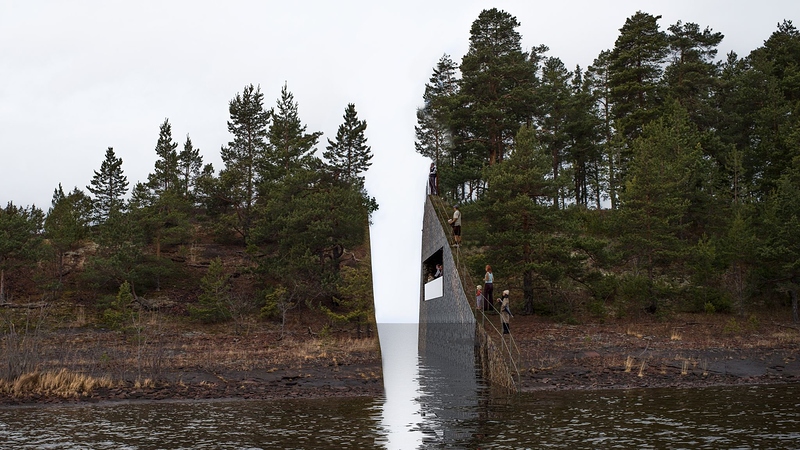The open letter below was circulated today by an international group of artists and curators in defense of Memory Wound, a proposed memorial by artist Jonas Dahlberg to be installed on Norway’s Utøya island, where 77 people, most of them children, were massacred on July 22, 2011. The Norwegian government, in response to lawsuits brought by local residents who live near the memorial site, is considering cancelling the installation of the memorial. We republish the open letter in full, including its many signatories (the letter originally circulated over email in PDF format):
The installation of Jonas Dahlberg’s work of art, Memory Wound, on Sørbråten has caused heated debate for some time now. The memorial was scheduled to be completed in 2015, but now it is turning into a difficult legal case, jeopardising the plans to realise one of the most important public works of art in the Nordic region in our time, and a crucial manifestation against terrorism. It is hardly surprising that the design of a memorial site is accompanied by debate; this is always the case – because there are strong feelings, and the purpose is to keep the memory alive, and the memory is painful. The discussions are not a problem; they are an essential part of the process, a strategy for coping with the event.
The purpose of memorials is precisely to preserve a memory; living with it enables us to process it. All over the world, memorials have proved to have a healing effect, not just nationally but eventually in the local area. What would happen if we refrained from creating memorials because we were afraid that they might be upsetting? What kind of society would that engender?
Jonas Dahlberg’s design is one of the most powerful works of art in the Nordic countries. Memory Wound is a gash in the bedrock, a wound in nature. For walkers along the pathway it presents a serene and beautiful place for contemplation between sea and cliffs. Jonas Dahlberg forces us to look inwards, away from the island, so that we can embrace the greater sorrow within ourselves.
The work of art is already established in people’s minds all over the world. It has been published in newspapers and books and discussed in workplaces and around dinner tables. The reason for this is that it so poignantly captures the event that it was designed to remind us of, while offering a place for coping with our grief. That is exactly what art is capable of: to give us an emotional relationship to events that are so brutal that they are impossible to comprehend.
In this discussion, it is vital to remember that it is not the work of art that is brutal but the actions that it commemorates. To stop such a work of art is to reduce the magnitude of the event itself. It is to deny people access to their own feelings, to refuse to offer reflection on the value of democratic society.
We appeal to the Norwegian government to be brave and allow Memory Wound to become a dignified place of healing through processing the wounds rather than suppressing them.
Miroslaw Balka, artist Warszawa, and reponible for Estonia monument in Stockholm
Daniel Birnbaum, director Moderna Museet Stockholm
Konrad Bitterli, vice- director Kunstmuseum St.Gallen
Iwona Blazwick, director Whitechapel Art Gallery, London
Ina Blom, professor, IFIKK, Institutt for filosofi, ide- og kulturhistorie og klassiske språk Oslo Universitet
Mikkel Bogh, director Statens Museum for Kunst, Köpenhamn
Manuel Borja-Villel, director Museo Nacional Centro de Arte Reina Sofía, Madrid
Gerard Byrne, artist Dublin Dan Cameron, curator Prospect I and II, Cuenca Biennial, New York
Lauren Cornell, curator New Museum, New York
Florence Derieux curator Centre Pompidou Foundation Paris og New York
Claire Doherty, director Situations Bristol
Olafur Eliasson, artist Berlin
David Elliott, curator, previously director Mori Art Museum Tokyo
Charles Esche, director Vanabbe Museum
Dora Garcia, artist and professor of visual arts, Kunstakademiet Oslo
Eva Gonzales Sancho, curator, previously director for FRAC Bourgogne
Leevi Haapala, director Kiasma Hesinki
Tone Hansen, director Henie Onstad Kunstsenter Oslo
Sofia Hernandez Chong Cuy, curator CPPCA (Art and Ideas from Latin America), New York
Alfredo Jaar, artist New York
Hicham Khalidi, associate curator Fondation d’entreprise Galeries Lafayette, Paris
Magdalena Malm, director Statens Konstråd, Stockholm
Chus Martinez, curator Institute of Art at FHNW Academy of Art and Design, Basel
David Neuman, director Magasin 3, Stockholm
Isabella Nilsson director Göteborgs konsthall
Lars Nittve, senior advisor M+, Hong Kong
Marit Paasche, art critic and museum curator
Ann Pasternak, director Brooklyn Museum
Laura Raikowitz, director Queens Museum
Mats Stjernstedt, artistic director Hus, Oslo
Kjetil Trædal Thorsen, founding partner Snöhetta, Oslo
Nato Thompson, chief curator Creative Time New York
Sabrina van der Ley, head of contemporary art department, Nasjonalmuseet for kunst, arkitektur og design Oslo
Philippe Vergne, director MOCA, The museum of contemporary art Los Angeles
Image: Mock-up of Jonas Dahlberg’s Memory Wound memorial.
